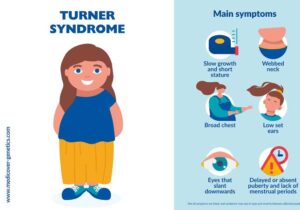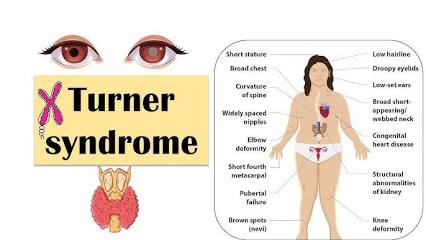Turner syndrome is a genetic condition that affects females, caused by the complete or partial absence of one X chromosome. This change in chromosome number or structure can influence growth, development, and reproductive health. Although there is no cure, a range of treatments can help manage symptoms and support overall well-being.
Causes
Turner syndrome results from a missing or altered X chromosome. In some cases, the abnormality is present in every cell of the body, while in others—known as mosaic Turner syndrome—only some cells are affected.
The chromosome change typically occurs due to a random error during the formation of reproductive cells (egg or sperm), rather than being inherited from a parent.
 Common Signs and Symptoms
Common Signs and Symptoms
- Short stature – Most girls grow more slowly than their peers and are shorter than average as adults.
- Delayed or absent puberty – Breast development, menstruation, and other puberty milestones may be delayed or not occur without medical intervention.
- Infertility – Ovaries may not develop fully or function properly, often leading to difficulties conceiving.
- Distinctive physical traits – These can include a webbed neck, low-set ears, a broad chest, and a low hairline.
- Associated health conditions – Some individuals may have heart defects, kidney abnormalities, thyroid problems, hearing loss, or an increased likelihood of developing high blood pressure or type 2 diabetes.
Treatment and Support Options
While Turner syndrome cannot be cured, treatments can address specific challenges:
- Growth hormone therapy – Encourages increased height when started early in childhood.
- Estrogen replacement therapy – Supports the onset of puberty, menstrual cycles, and bone health.
- Targeted medical care – Surgery or other interventions for heart or kidney conditions, hearing aids, and thyroid management.
- Supportive services – Counseling, academic assistance, and social support to help manage learning or emotional difficulties.
Key Considerations
Turner syndrome varies greatly from person to person—some may have mild symptoms, while others face more significant challenges. Early diagnosis, regular monitoring, and tailored treatment plans can significantly improve health outcomes and quality of life.






